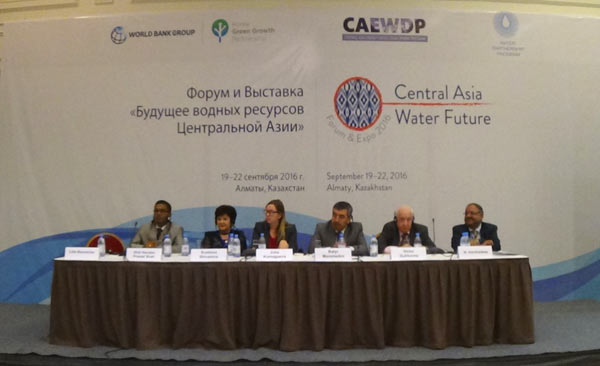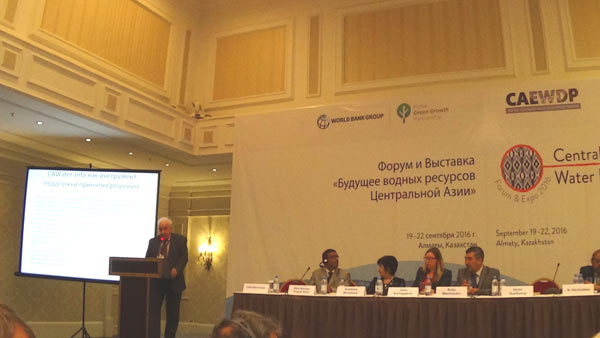CENTRAL ASIAL WATER FUTURE: A WORLD BANK FORUM AND EXPO
19-23 September 2016, Almaty, Kazakhstan

During a four-day conference on water management practices in Central Asia, participants explored progress on water management in Central Asia and got acquainted with the showcased global good practices on modernization of water management information systems. The conference intended to capture best practices to better refine activities proposed for the Central Asia Water Management (CAWaRM) Project. The World Bank organized this event in three directions titled as ‘III’ – Information, Institutional Framework, and Investments.
The event brought together over 200 participants; however, parallel organization of the Scientific-Practical Conference by UNESCO and the Kazakhstan’s Ministry of Agriculture and Water Resources and invitation of policy and decision makers to this Conference allowed attracting the heads of water management organizations from Kazakhstan, Turkmenistan, Uzbekistan and the lower level officials from Tajikistan. It is characteristic that the representatives of the Afghanistan’s Ministry of Energy and Water Resources in the person of Director of Department and Deputy Minister participated in this event.

Contrary to usual conference agenda, the event began from training rather than from plenary meeting. The training was focused on four areas, such as data and modeling, weather and climate, observation and monitoring network, and data management.
The report by Dr.Harshadeep attracted apparent interest. He talked about an interesting World Bank’s apps “Spatial Agent”, which serves as a ‘library’ of global datasets related to water resources and other fields of sustainable development. This tool integrates all developed datasets with free access on socio-economy and water and land use. However, this tool mainly covers global level and to lesser degree – regional level, thus making it usable for comparison of mainly these two levels.
D.Fields focused the training on two models. The first model is a modeling platform AralDIF developed at the Washington University. AralDIF models the Aral Sea basin with yearly, seasonal and even daily time step by using global data; however, during demonstration, the model produced output that did not agree with actual flow hydrograph. The second product was presented by Abdulkarim Seid, the Nile Basin Secretariat. The presented by him decision support system was interesting since the model considered 11 countries. It is based on the well-known modeling software, such as MIKE, SWAT, and WEAP but is limited to only long-term basin management.
The Forum was welcomed by a representative of the World Bank Headquarters, Global Water Practice Manager Mr. M.Haney, who particularly underlined a need to combat drought, taking into account conclusions in the working paper «High and dry» that indicated to population reaching 9 millions, agricultural products demand growing by 40-50 % and energy demand increasing by 50 %. According to him, by 2050, water scarcity would increase by 40 %, especially due to ever increased consumption of proteins.
Prof. V.A. Dukhovniy, Director of SIC ICWC underlined in his speech about application of remote sensing (RS) that RS cannot replace collection, analysis, and organization of ground-derived data, taking into account their usability for on-line control and accuracy of observations, especially noting that higher resolution images are not free of charge. A representative of Kazakhstan added that the country launched a number of satellites with higher accuracy that provided free images.

Two keynote reports differed in their content and focus. Acting Deputy Director of IWMI Ian Makin, despite location of his institution in Central Asia, organized his report in form of a mosaic of IWMI’s global experience rather than around concrete tasks in the region. On the contrary, ex-chairman of EC IFAS Prof. S.Ibatullin, who now chairs the World Bank’s Central Asia policy group of experts, made a very good report on the work of this group. In particular, he focused on 2012 proposals of the EC IFAS working group regarding establishment of Central Asia information space and development of institutional mechanisms that would have their impact on country relations in the region and enhancement of cooperation. Some technical approaches on water resource estimation in catchment areas were addressed in the report of the U.S. researcher Dr.Bair, particularly estimation of snow water equivalent by using radars.
Mark Heggli presented methods for non-contact measurements of flow rates as used in the USA and gave assessment of capabilities to use these mechanisms in CA based on his survey of the state-of-affairs in BWO Syrdarya.
Head of regional PMU for Central Asia Hydromet Modernization Project Yerdos Kubakov reported that the accuracy of flow forecast increased to 71% for Kyrgyzstan and to 75% for Tajikistan as a result of the project under consideration.
Kyrgyz researcher Dr. Ryskul Usubaliev reported on the results of CAIAG work related to monitoring of glaciers in context of climate change. A few reports were dedicated also to monitoring of natural environment and water resources in the Central Asian countries: Ms. G.Tilyavova (BWO Amudarya), Mr. F.Irmatov (BWO Syrdarya), Ms. E.Sahvaeva (Chu-Talas Commission).
Report by Mr. A.Sorokin about the improvement and free use of the ASBMM model arouse interest. The model was presented in context of present-day approaches and practices of water resource management by basin water organizations. Although Kazakhstan continues their efforts in the Aral Sea basin as a whole, drastic deterioration of water education level is observed in Kazakhstan, stated Mr. A.Kenshimov. At the same time, he stressed the importance of the development of information network and information on water management to be accessible online and the support of water cooperation.
A participant from Egypt spoke about capacity building activities on the western bank of Nile that involved 16 universities developing jointly an interactive toolbox.
Barbara Janusz-Pawletta, Kazakh-German University, took stock of the five-year University activity related to preparation of masters for IWRM. She underlined that KGU has become a member of UNESCO. While developing a new master program, KGU popularizes life-long training. She also noted that the Russian-speaking audience decreases in Central Asia, while the English-speaking one does not increase. Education in native languages is an advantage; however, knowledge of either Russian or English or the both languages critically increases the ability to gain knowledge on a global scale. Water practices in Pakistan and Afghanistan were presented by the experts from these countries. The presentation by Deputy Minister of Energy and Water (Afghanistan) Mr. Fahimullah Ziaie and the following report by Mr. Anvar Khamidov (Tajikistan) about UNECE-supported cooperation between Tajikistan and Afghanistan on information system in Upper Pyandj, which lacked water observations for already 18 years, aroused particular interest. In November 2014, an agreement was signed on information exchange and then a joint expedition was undertaken to Tigrovaya Balka, several automatic gauging stations were installed in the area of Horog, and the Afghan-Tajik Cooperation Atlas was published.
The representative of Turkmenistan spoke about preparation of a new Water code and formation of dekhkan associations (similar to WUAs in other countries).
The next session was opened by the new Central Asia Country Director of the World Bank Ms. Lilia Burunciuc, who underlined that the World Bank would continue supporting cooperation, information exchange, innovations, and e-learning.
An interesting report was read by the Under Secretary of the Ministry of Agriculture (Nepal) Mr. Sh.N. Prasad Shah about the agro-advisory systems. A special portal was opened for farmers and included the early warning system. 1300 small measurement stations were installed, farmers were provided with smartphones, and the central advisory center was established to answer farmers’ questions. Publication of monthly agro-information newsletters was organized. The system covers 5500 agricultural units, trains farmers, and provides recommendations for marketing matters.
Ms. S.Shivaryova (RHC) and Yu. Komagaeva (World Bank) in their presentations demonstrated activities done under the WB’s CAWDEP. In particular, a Kazakhstan intersectoral group of 11 persons for water disasters was established, the Inventory of risks in Kazakhstan and Kyrgyzstan was composed. The WB’s training program is focused mainly on master’s degree (implemented by CAREC). In this context, a competition of master’s studies is undertaken to exchange technologies and knowledge.
Prof. V.Dukhovniy in his presentation underlined the role of SIC ICWC in the development of a unique regional information system. Unfortunately, the World Bank and other donors did not pay attention to the program of common information space developed by EC IFAS working group and agreed by ICWC. KDC Energy, RHC and a number of other organizations take part in this common space.
An interesting message was delivered by a representative of Afghanistan. They established a national Water council to coordinate water activities, develop programs for water assessment, flow forecasting and water development. It is planned to build 25 monitoring stations.
The round-table meeting was also held on the CAWaRM Program context. Deputy Minister of Agriculture and Water Resources of Uzbekistan Mr. Sh.Khamraev took the floor and appealed to the World Bank to start the project as soon as possible as the preparatory phase was too prolonged. He also criticized figures from academia who called to neglect the Aral Sea Basin Program. It is not a matter of the sea itself but of the future of its basin. We may not forget that irrigation feeds, waters, and gives jobs to more than 50% of population in the region!
Prof. V.A.Dukhovniy
Director, SIC ICWC
|